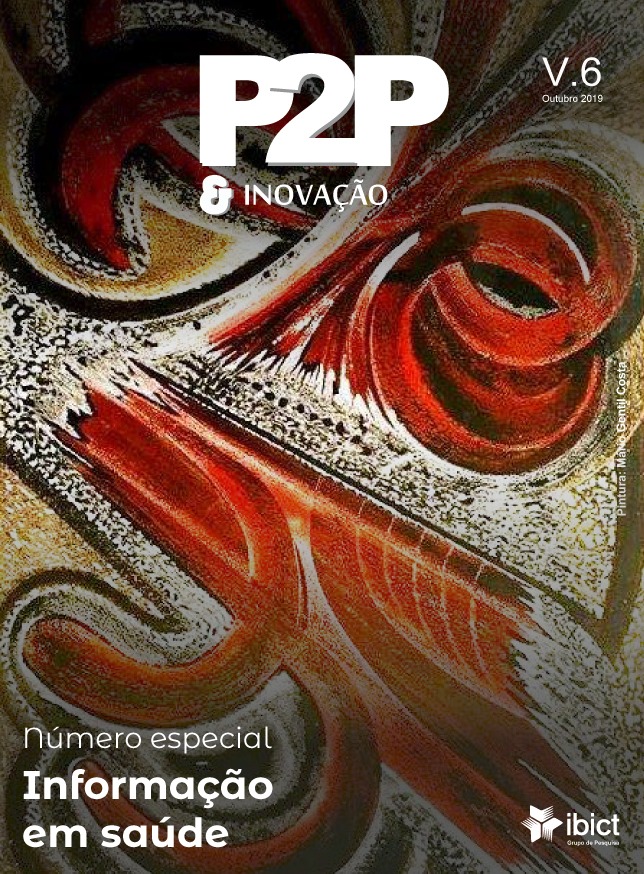AS REVISÕES SISTEMÁTICAS COMO FONTES DE EVIDÊNCIAS NAS RECOMENDAÇÕES DE SAÚDE: O CASO DA AMAMENTAÇÃO E A SAÚDE DA CRIANÇA
DOI:
https://doi.org/10.21721/p2p.2019v6n1.p133-174Resumo
As revisões sistemáticas são uma síntese metodologicamente construída a partir dos estudos originais consideradas eficientes geradoras de evidências científicas para as decisões de saúde, porém sua qualidade pode interferir limitando sua utilização. Sua importância se percebe pela crescente produção e utilização nas recomendações de saúde. Tais recomendações baseadas em evidências científicas, elaboradas por instituições de reconhecida influência orientam o comportamento sobre as ações de saúde. O objetivo deste estudo foi investigar as revisões sistemáticas como fontes de evidências científicas das recomendações sobre o tema as repercussões da amamentação na saúde da criança. Se fez uma análise de citação para identificar as revisões sistemáticas referenciadas nas recomendações de instituições internacionais e do Brasil, Estados Unidos e Canadá. A qualidade metodológica das revisões foi avaliada usando Amstar. Foram selecionadas 101 recomendações que citaram 30 revisões sistemáticas. As revisões são de qualidade moderada e ainda insuficientes quanto à temática e aos achados e foram escassamente citadas.
Downloads
Referências
AGENCY FOR HEALTHCARE RESEARCH AND QUALITY. Breastfeeding and maternal and infant health outcomes in developed countries. Evidence Report/Technology Assessment No. 153 AHRQ Publication No. 07-E007. Rockville, MD: AHRQ, 2007.
AMERICAN ACADEMY OF PEDIATRICS. Breastfeeding and the use of human milk. Pediatrics, v. 129, n. 3, p. e827-841, 2012.
ANDERSON, J. W.; JOHNSTONE, B. M.; REMLEY, D. T. Breast-feeding and cognitive development: a meta-analysis. American Journal of Clinical Nutrition, v. 70, n. 4, p. 525-535, 1999.
ARENZ, S. et al. Breast-feeding and childhood obesity - a systematic review. International Journal of Obesity, v. 28, n. 10, p. 1247-1256, 2004.
BRASIL. Ministério da Saúde. Secretaria de Ciência Tecnologia e Insumos Estratégicos; Departamento de Ciência e Tecnologia. Diretrizes metodológicas: elaboração de revisão sistemática e metanálise de ensaios clínicos randomizados. Brasília: Ministério da Saúde, 2012. (Série A: Normas e manuais técnicos).
BRASIL; MINISTÉRIO DA SAÚDE; DEPARTAMENTO DE CIÊNCIA E TECNOLOGIA. Avaliação de tecnologias em saúde: institucionalização das ações no Ministério da Saúde. Revista de Saúde Pública, v. 40, n. 4, p. 743-747, 2006.
BRASIL; MINISTÉRIO DA SAÚDE; ORGANIZAÇÃO PAN-AMERICANA DA SAÚDE. Guia alimentar para crianças menores de 2 anos. Brasília: Ministério da Saúde, 2002.
BURDA, B. U.; CHAMBERS, A. R.; JOHNSON, J. C. Appraisal of guidelines developed by the world health organization. Public Health, v. 128, n. 5, p. 444-474, 2014.
CENTRE FOR REVIEWS AND DISSEMINATION. Systematic reviews: CRD's guidance for undertaking reviews in health care. York: University of York, 2009.
DICKINSON, H. D. A sociological perspective on the transfer and utilization of social scientific knowledge for policymaking. In: LIMIEUX-CHARLES, L.; CHAMPAGNE, F. (ed.). Using knowledge and evidence in health care: multidisciplinary perspectives. Toronto: University of Toronto, 2004, p. 41-69.
DOBBINS, M. et al. Public health decision-makers’ informational needs and preferences for receiving research evidence. Worldviews on Evidence-Based Nursing, v. 4, n. 3, p. 156-163, 2007a.
FLETCHER, J. What is heterogeneity and is it important? British Medical Journal, v. 334, n. 7584, p. 94-96, 2007.
FRANCO, A.; MALHOTRA, N.; SIMONOVITS, G. Social science. publication bias in the social sciences: Unlocking the file drawer. Science, v. 345, n. 6203, p. 1502-1505, 2014.
GDALEVICH, M. et al. Breast-feeding and the onset of atopic dermatitis in childhood: A systematic review and meta-analysis of prospective studies. Journal of the American Academy of Dermatology, v. 45, n. 4, p. 520-527, 2001.
GREENHALGH, T. Como ler artigos científicos: fundamentos da medicina baseada em evidências. 3. ed. Porto Alegre: Artmed, 2008.
GUYATT, G. et al. A filosofia da medicina baseada em evidências. In: GUYAT, G. et al. Diretrizes para utilização da literatura médica. 2. ed. Porto Alegre: Artmed, 2011a. p. 31-37.
GUYATT, G. et al. Grade guidelines: 1. Introduction-grade evidence profiles and summary of findings tables. Journal of Clinical Epidemiology, v. 64, n. 4, p. 383-394, 2011b.
HEALTH CANADA et al. Nutrition for healthy term infants: recommendations from birth to six months: A joint statement of Health Canada, Canadian Paediatric Society, Dietitians of Canada and Breastfeeding Committee of Canada. Disponível em: http://www.hc-sc.gc.ca/fn-an/nutrition/infant-nourisson/recom/index-eng.php. Acesso em: 18 maio 2018.
HEMINGWAY, P.; BRERETON, N. What is a systematic review? London: Hayward Medical Communication, 2009 (Whatis series).
HIGGINS, J. P. T., et al. Cochrane handbook for systematic reviews of interventions. Version 5.1.0. (updated march 2011). 2011. Disponível em: <http://handbook.cochrane.org>. Acesso em 15 dez. 2017.
KRAMER, M.; KAKUMA, R. The optimal duration of exclusive breastfeeding: a systematic review.Geneve: WHO, 2002a
KRAMER, M.; KAKUMA, R. Optimal duration of exclusive breastfeeding. The Cochrane Database of Systematic Reviews, n. 1, p. Cd003517, 2002b.
KRAMER, M.; KAKUMA, R. Optimal duration of exclusive breastfeeding. The Cochrane Database of Systematic Reviews, n. 1, p. CD003517, 2009.
KRAMER, M.; KAKUMA, R. The optimal duration of exclusive breastfeeding: a systematic review. Advances in Experimental Medicine and Biology, v. 554, n., p. 63-77, 2004.
KRAMER, M. S.; KAKUMA, R. Optimal duration of exclusive breastfeeding. The Cochrane Database of Systematic Reviews, n. 8, p. Cd003517, 2012
LAVIS, J. H. et al. How can research organizations more effectively transfer research knowledge to decision makers? The Milbank Quarterly, v. 81, n. 2, p. 221-248, 2003.
LEVINE, M. et al. Dano (estudos observacionais). In: GUYAT, G. et al. Diretrizes para utilização da literatura médica. 2. ed. Porto Alegre: Artmed, 2011, p. 319-334.
LIMIEUX-CHARLES, L.; CHAMPAGNE, F. (eds.). Using knowledge and evidence in health care: multidisciplinary perspectives. Toronto: Univesity of Toronto, 2004
LOHR, K. N. Rating the strength of scientific evidence: Relevance for quality improvement programs. International Journal for Quality in Health Care, v. 16, n. 1, p. 9-18, 2004.
LOMAS, J. et al. Conceptualizing and combining evidence for health system guidance: final report. Ottawa: Canadian Health Service Research Foundation, 2005.
LOMAS, J. Understanding evidence-based decisions-making: or why keyboards are irrational. In: LEMIEUX-CHARLES, L.; CHAMPAGNE, F. (ed.). Using knowledge and evidence in health care: multidisciplinary perspectives. Toronto: University of Toronto, 2004. p. 281-290.
MACROBERTS, M. H.; MACROBERTS, B. R. Problems of citation analysis: a study of uncited and seldom-cited influences. Journal of the American Society for Information Science and Technology, v. 61, n. 1, p. 1-13, 2010.
MARTÍNEZ-SILVEIRA, M. S. Bibliotecários são parceiros valiosos em equipes de revisões sistemáticas. X CINFORM Encontro Nacional de Ensino e Pesquisa em Informação. Anais [...] Salvador, Bahia: UFBA 2011.
MEERPOHL, J. J. et al. Scientific value of systematic reviews: survey of editors of core clinical journals. PLoS One, v. 7, n. 5, p. e35732, 2012.
NICOLAISEN, J. Citation analysis. Annual Review of Information Science and Technology, v. 41, n., p. 609-641, 2007.
NUTLEY, S. M.; WALTER, I.; DAVIES, H. T. O. Using evidence: how research can inform public services. Bristol, UK: University of Bristol, 2007
OXMAN, A. D.; LAVIS, J. N.; FRETHEIM, A. Use of evidence in WHO recommendations. Lancet, v. 369, n. 9576, p. 1883-1889, 2007.
PETTICREW, M. et al. Quality-assessed reviews of health care interventions and the database of abstracts of reviews of effectiveness (dare). NHS CRD review, dissemination, and information teams. International Journal of Technology Assessment in Health Care, v. 15, n. 4, p. 671-678, 1999.
PETTICREW, M.; ROBERTS, H. Systematic reviews in the social sciences: a practical guide. Malden, MA: Blackwell, 2006
RELEVO, R. Effective search strategies for systematic reviews of medical tests: chapter 4. Journal of General Internal Medicine, v. 27 Suppl 1, n., p. S28-32, 2012.
SAMPSON, M. et al. An evidence-based practice guideline for the peer review of electronic search strategies. Journal of Clinical Epidemioly, v. 62, n. 9, p. 944-952, 2009.
SHEA, B. J. et al. AMSTAR is a reliable and valid measurement tool to assess the methodological quality of systematic reviews. Journal of Clinical Epidemiology, v. 62, n. 10, p. 1013-1020, 2009.
SHEA, B. J. et al. External validation of a measurement tool to assess systematic reviews (AMSTAR). PLoS One, v. 2, n. 12, p. e1350, 2007.
TITLER, M. G. The evidence for evidence-based practice implementation. In: HUGHES, R. G. (ed.). Patient safety and quality: an evidence-based handbook for nurses. Rockville, MD: AHRQ, 2008. cap. 7, p. 1-49
UPSHUR, R. E. G. Seven characteristics of medical evidence. Journal of Evaluation in Clinical Practice, v. 6, n. 2, p. 93-97, 2000.
WORLD HEALTH ORGANIZATION COLLABORATIVE STUDY TEAM ON THE ROLE OF BREASTFEEDING ON THE PREVENTION OF INFANT MORTALITY. Effect of breastfeeding on infant and child mortality due to infectious diseases in less developed countries: a pooled analysis. Lancet, v. 355, n. 9202, p. 451-455, 2000.
WORLD HEALTH ORGANIZATION. Planning guide for national implementation of the global strategy for infant and young child feeding. Geneva: WHO, 2007.
WORLD HEALTH ORGANIZATION. WHO handbook for guideline development. Geneva: WHO, 2012.
WORLD HEALTH ORGANIZATION. Exclusive breastfeeding for six months best for babies everywhere. 2011. Disponível em: http://www.who.int/mediacentre/news/statements/2011/breastfeeding_20110115/en/%3E. Acesso em: 10 jan. 2019.
WORLD HEALTH ORGANIZATION. Infant and young child feeding: model chapter for textbooks for medical students and allied health professional. Geneva: WHO, 2010.
Arquivos adicionais
Publicado
Edição
Seção
Licença
A revista é publicada sob a licença Creative Commons - Atribuição - Uso Não Comercial - Partilha nos Mesmos Termos 4.0 Internacional.
O trabalho publicado é considerado colaboração e, portanto, o autor não receberá qualquer remuneração para tal, bem como nada lhe será cobrado em troca para a publicação.
Os textos são de responsabilidade de seus autores.
É permitida a reprodução total ou parcial dos textos da revista, desde que citada a fonte.















